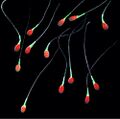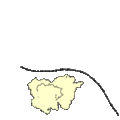Biology:Motility
File:Binucleated cell overlay.tiff
Motility is the ability of an organism to move independently, using metabolic energy.
Definitions
Motility, the ability of an organism to move independently, using metabolic energy,[2][3] can be contrasted with sessility, the state of organisms that do not possess a means of self-locomotion and are normally immobile. Motility differs from mobility, the ability of an object to be moved. The term vagility encompasses both motility and mobility; sessile organisms including plants and fungi often have vagile parts such as fruits, seeds, or spores which may be dispersed by other agents such as wind, water, or other organisms.[4]
Motility is genetically determined,[5] but may be affected by environmental factors such as toxins. The nervous system and musculoskeletal system provide the majority of mammalian motility.[6][7][8]
In addition to animal locomotion, most animals are motile, though some are vagile, described as having passive locomotion. Many bacteria and other microorganisms, and multicellular organisms are motile; some mechanisms of fluid flow in multicellular organs and tissue are also considered instances of motility, as with gastrointestinal motility. Motile marine animals are commonly called free-swimming,[9][10][11] and motile non-parasitic organisms are called free-living.[12]
Motility includes an organism's ability to move food through its digestive tract. There are two types of intestinal motility – peristalsis and segmentation.[13] This motility is brought about by the contraction of smooth muscles in the gastrointestinal tract which mix the luminal contents with various secretions (segmentation) and move contents through the digestive tract from the mouth to the anus (peristalsis).[14]
Cellular level
At the cellular level, different modes of movement exist:
- amoeboid movement, a crawling-like movement, which also makes swimming possible[16][17]
- filopodia, enabling movement of the axonal growth cone[18]
- flagellar motility, a swimming-like motion (observed for example in spermatozoa, propelled by the regular beat of their flagellum, or the E. coli bacterium, which swims by rotating a helical prokaryotic flagellum)
- gliding motility
- swarming motility
- twitching motility, a form of motility used by bacteria to crawl over surfaces using grappling hook-like filaments called type IV pili.
Many cells are not motile, for example Klebsiella pneumoniae and Shigella, or under specific circumstances such as Yersinia pestis at 37 °C.[citation needed]
Movements
Events perceived as movements can be directed:
- along a chemical gradient (see chemotaxis)
- along a temperature gradient (see thermotaxis)
- along a light gradient (see phototaxis)
- along a magnetic field line (see magnetotaxis)
- along an electric field (see galvanotaxis)
- along the direction of the gravitational force (see gravitaxis)
- along a rigidity gradient (see durotaxis)
- along a gradient of cell adhesion sites (see haptotaxis)
- along other cells or biopolymers
Muscles give the ability for voluntary movement, and involuntary movement as in muscle spasms and reflexes). At the level of the muscular system, motility is a synonym for locomotion.[19][20]
Most sperm have a single flagellum to help them swim. The cervical, uterine, and fallopian linings of the female reproductive system play a more important role in transporting sperm to ova.
The shoots of plants move by growing towards light. This is known as positive phototropism. The roots grow away from light. This is known as negative phototropism.
Monocytes and macrophages of the immune system engulf Bacteria by extending their pseudopodia. Note that this cartoon is not an accurate representation of phagocytosis.
Motility at the sub-cellular level. This depicts translation - a motile nanoscale molecular process using protein dynamics.
See also
References
- ↑ Clegg, Chris (2008). "3.2 Cells make organisms". Edexcel biology for AS (6th ed.). London: Hodder Murray. p. 111. ISBN 978-0-340-96623-5. "Division of the cytoplasm, known as cytokinesis, follows telophase. During division, cell organelles such as mitochondria and chloroplasts become distributed evenly between the cells. In animal cells, division is by in-tucking of the plasma membrane at the equator of the spindle, 'pinching' the cytoplasm in half (Figure 3.15). In plant cells, the Golgi apparatus forms vesicles of new cell wall materials which collect along the line of the equator of the spindle, known as the cell plate. Here, the vesicles coalesce forming the new plasma membranes and cell walls between the two cells (Figure 3.17)."
- ↑ "Motility". http://jcb.rupress.org/content/jcb/91/3/148s.full.pdf.
- ↑ "Online Etymology Dictionary". http://www.etymonline.com/index.php?term=motility. ""capacity of movement," 1827, from French motilité (1827), from Latin mot-, stem of movere "to move" (see move (v.))."
- ↑ "Botanical Nerd Word: Vagile". 7 November 2016. https://torontobotanicalgarden.ca/blog/word-of-the-week/botanical-nerd-word-vagile/.
- ↑ Nüsslein-Volhard, Christiane (2006). "6 Form and Form Changes". Coming to life: how genes drive development. San Diego, California: Kales Press. p. 75. ISBN 978-0979845604. https://books.google.com/books?id=n19wkrmFJhwC&pg=PA73. "During development, any change in cell shape is preceded by a change in gene activity. The cell's origin and environment that determine which transcription factors are active within a cell, and, hence, which genes are turned on, and which proteins are produced."
- ↑ Fullick, Ann (2009). "7.1". Edexcel A2-level biology. Harlow: Pearson. p. 138. ISBN 978-1-4082-0602-7.
- ↑ Fullick, Ann (2009). "6.1". Edexcel A2-level biology. Harlow: Pearson. p. 67. ISBN 978-1-4082-0602-7.
- ↑ E. Cooper, Chris; C. Brown, Guy (October 2008). "The inhibition of mitochondrial cytochrome oxidase by the gases carbon monoxide, nitric oxide, hydrogen cyanide and hydrogen sulfide: chemical mechanism and physiological significance". Journal of Bioenergetics and Biomembranes 40 (5): 533–539. doi:10.1007/s10863-008-9166-6. PMID 18839291.
- ↑ Krohn, Martha M.; Boisdair, Daniel (May 1994). "Use of a Stereo-video System to Estimate the Energy Expenditure of Free-swimming Fish". Canadian Journal of Fisheries and Aquatic Sciences 51 (5): 1119–1127. doi:10.1139/f94-111.
- ↑ Cooke, Steven J.; Thorstad, Eva B.; Hinch, Scott G. (March 2004). "Activity and energetics of free-swimming fish: insights from electromyogram telemetry". Fish and Fisheries 5 (1): 21–52. doi:10.1111/j.1467-2960.2004.00136.x. "We encourage the continued development and refinement of devices for monitoring the activity and energetics of free-swimming fish".
- ↑ Carey, Francis G.; Lawson, Kenneth D. (February 1973). "Temperature regulation in free-swimming bluefin tuna". Comparative Biochemistry and Physiology A 44 (2): 375–392. doi:10.1016/0300-9629(73)90490-8. PMID 4145757. "Acoustic telemetry was used to monitor ambient water temperature and tissue temperature in free-swimming bluefin tuna (Thunnus thynnus Linneaus [sic], 1758) over periods ranging from a few hours to several days.".
- ↑ "About Parasites". Centers for Disease Control. https://www.cdc.gov/parasites/about.html. "Protozoa are microscopic, one-celled organisms that can be free-living or parasitic in nature."
- ↑ -overview Intestinal Motility Disorders at eMedicine
- ↑ Wildmarier, Eric P.; Raff, Hershel; Strang, Kevin T. (2016). Vander's Human Physiology: The Mechanisms of Body Function (14th ed).. New York, NY: McGraw Hill. pp. 528.
- ↑ Alberts, Bruce; Johnson, Alexander; Lewis, Juian; Raff, Martin; Roberts, Keith; Walter, Peter (2008). "16". Molecular biology of the cell (5th ed.). New York: Garland Science. p. 965. ISBN 978-0-8153-4106-2. "For cells to function properly, they must organize themselves in space and interact mechanically with their environment... Eucaryotic cells have developed... the cytoskeleton... pulls the chromosomes apart at mitosis and then splits the dividing cell into two... drives and guides intracellular traffic of organelles... enables cells such as sperm to swim and others, such as fibroblasts and white blood cells, to crawl across surfaces. It exhibits wide range of movement"
- ↑ Van Haastert, Peter J. M. (2011). "Amoeboid Cells Use Protrusions for Walking, Gliding and Swimming". PLOS ONE 6 (11): e27532. doi:10.1371/journal.pone.0027532. PMID 22096590. Bibcode: 2011PLoSO...627532V.
- ↑ Bae, A. J.; Bodenschatz, E. (2010). "On the swimming of Dictyostelium amoebae". Proceedings of the National Academy of Sciences 107 (44): E165–6. doi:10.1073/pnas.1011900107. PMID 20921382. Bibcode: 2010PNAS..107E.165B.
- ↑ Gilbert, Scott (2006). Developmental biology (8th. ed.). Sunderland, Mass.: Sinauer Associates, Inc. Publishers. p. 395. ISBN 9780878932504.
- ↑ Parsons, Richard (2009). "Unit 5 Section 1". A2-level biology : the revision guide : exam board: Edexcel. Broughton-in-Furness: Coordination Group Publications. p. 50. ISBN 978-1-84762-264-8. "Skeletal muscle is the type of muscle you use to move, e.g. the bicep and triceps move the lower arm. Skeletal muscles are attached to bones by tendons. Ligaments attach bones to other bones, to hold them together. Skeletal muscles contract and relax to move bones at a joint."
- ↑ Vannini, Vanio; Jolly, Richard T.; Pogliani, Giuliano (1994). The new atlas of the human body : a full color guide to the structure of the body.. London: Chancellor Press. p. 25. ISBN 978-1-85152-984-1. "The muscle mass is not just concerned with locomotion. It assists in the circulation of blood and protects and confines the visceral organs. It also provides the main shaping component of the human form."
 |







